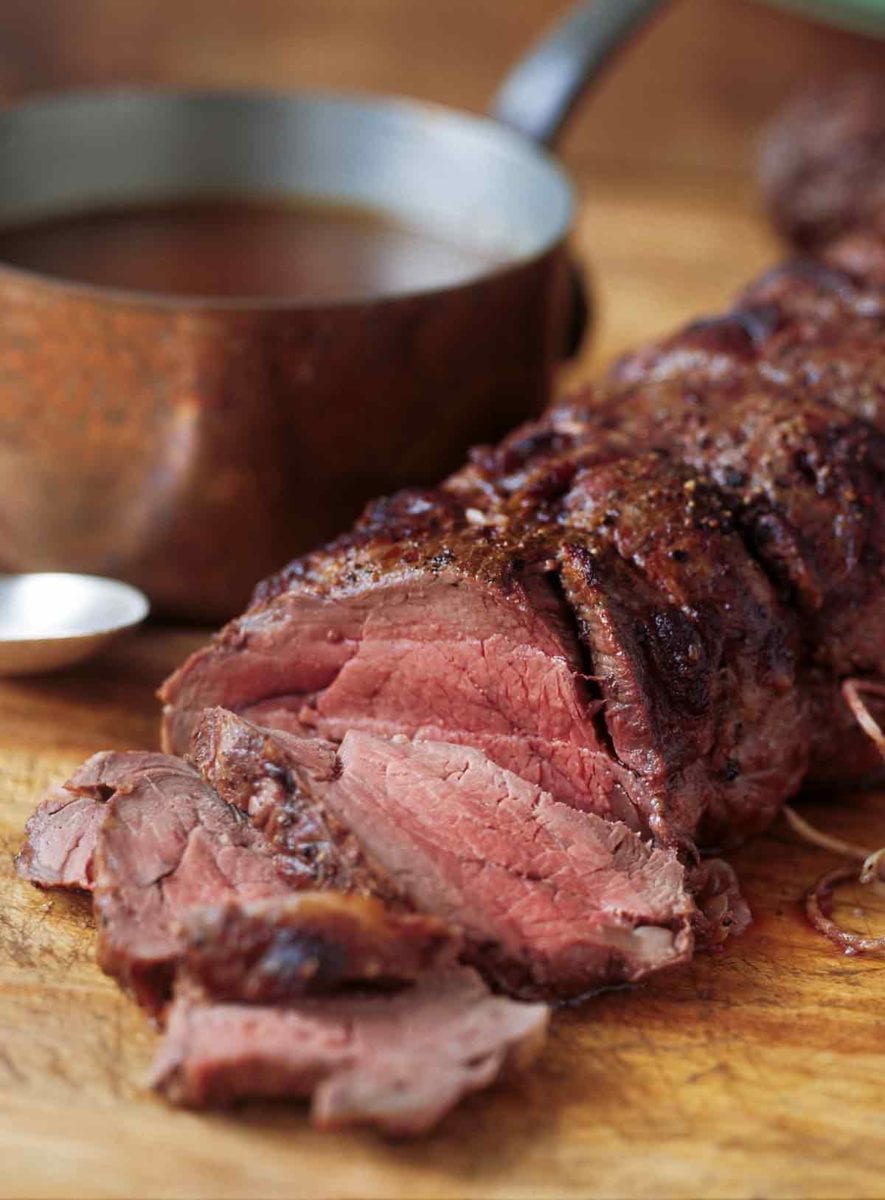Reduction Madeira Sauce for Beef Tenderloin
This beef tenderloin with Madeira sauce is ideal for Christmas or any special occasion thanks to the richly flavored, slightly boozy, complex tasting sauce and its simple foolproof cooking method. Perfect for when you wish to impress.

No more worrying about whether your fancy (and pricey) beef tenderloin will turn out perfectly for guests. This goof-proof beef tenderloin recipe is eminently reliable, requires no last-minute fussing, and doesn't ambush you with any last-minute carving trickery. It's just a simple, supple roast beef tenderloin napped with a slightly boozy but exceptionally well-balanced sauce. As easy as it is impressive.–Renee Schettler Rossi
Beef Tenderloin with Madeira Sauce

This beef tenderloin with Madeira sauce is ideal for Christmas or any special occasion thanks to the richly flavored, slightly boozy, complex tasting sauce and its simple foolproof cooking method. Perfect for when you wish to impress.
-
Kitchen string
For the beef tenderloin
- One (6-pound) whole beef tenderloin
- 4 tablespoons extra-virgin olive oil
- Kosher salt and freshly ground black pepper
- 2 1/2 pounds large Vidalia or other sweet onions about 5 (cut into slices 1/4-inch [6-mm] thick)
- 2 fresh thyme sprigs
- 1 tablespoon balsamic vinegar
For the Madeira sauce
- 1/2 cup Madeira (may substitute tawny port) or more as needed
- 3 cups beef stock or reduced-sodium beef broth
- 2 to 3 tablespoons beef demi-glace
- 1 tablespoon red wine vinegar
- Kosher salt and freshly ground black pepper
- 2 tablespoons (1 oz) unsalted butter at room temperature
- 2 tablespoons all-purpose flour
Cook the beef tenderloin
-
Preheat the oven to 425°F (220°C). Position a rack in the upper third of the oven.
-
Using a sharp, thin-bladed knife, remove the long thin muscle and connective tissue that runs almost the length of the beef tenderloin. Reserve it for another use, such as stir-frying or ground beef. Then remove and discard the silver skin and most of the surface fat from the tenderloin.
-
Next, about 5 to 6 inches (13 to 15 cm) from the narrow end of the beef tenderloin, make a shallow cut crosswise across the tenderloin, cutting about halfway through the meat. Fold this narrow end piece under so that the tenderloin is uniformly thick from one end to the other. Secure the tenderloin with kitchen string, tying it at 1 1/2-inch (4-cm) intervals along the length of the tenderloin.
-
Place the tenderloin on a rimmed baking sheet. Brush or rub the meat on all sides with 2 tablespoons of the olive oil. Season generously with salt and pepper, firmly pressing the seasonings in with your fingertips. (The roast can be refrigerated, uncovered, for up to 24 hours. Let stand at room temperature for about 1 hour before roasting.)
-
In a large skillet over low heat, warm the remaining 2 tablespoons olive oil. Add the onions, stir to coat with the oil, and season to taste with salt and pepper. Cook for 2 to 3 minutes, then add 1/4 cup water, the thyme, and the balsamic vinegar. Cover and cook over low heat, stirring occasionally, until the onions are very soft but not browned, about 15 minutes.
-
Uncover and, if any liquid remains in the skillet, increase the heat to medium-high and cook just until the liquid evaporates. Again, do not let the onions color.
-
Arrange the onions along the center of a shallow roasting pan just large enough to hold the tenderloin. (If you have a rather lengthy roast, you can spread the onions on the diagonal to make space for it in the pan.) Place the tenderloin on the onions. Roast the tenderloin until a thermometer inserted into the thickest part registers 125°F (52°C) for medium-rare, about 45 minutes. The roast will vary somewhat in doneness depending on the thickness of its sections.
-
Remove the pan from the oven, transfer the meat to a platter, and tent with aluminum foil. Let rest for 10 to 15 minutes before slicing.
Make the Madeira sauce
-
In a saucepan over medium-high heat, bring the 1/2 cup Madeira to a boil and cook until reduced to 1/4 cup.
-
Pour about 1/2 cup of the pan juices from the roasting pan through a fine-mesh sieve into the saucepan. Discard the thyme but reserve the onions in the roasting pan. Add the beef stock or broth to the saucepan, bring to a boil, and cook for 2 to 3 minutes to reduce slightly and blend the flavors. Reduce the heat to medium-low and stir in the demi-glace and red wine vinegar. Season to taste with salt and pepper and, if desired, 2 to 3 tablespoons more Madeira.
-
Meanwhile, place the butter and flour in a small bowl and mix with a fork until well combined to make a beurre manié. [Editor's Note: A beurre manié is a simple manner of thickening a sauce, lending it a rich, smooth, velvety consistency.] Reduce the heat under the sauce to low, whisk the beurre manié into the liquid a little at a time, and simmer until the sauce reaches the desired consistency, 2 to 3 minutes. Keep the sauce warm by covering it and placing it over very low heat.
-
Transfer the tenderloin to a carving board. Remove the strings and simply slice the roast into slices about 1/2 inch (12 mm) thick. Place a spoonful of the reserved onions onto individual plates and top with a slice of tenderloin. Spoon a little of the sauce over the meat and pass the remaining sauce at the table.
Serving: 1 portion Calories: 882 kcal (44%) Carbohydrates: 11 g (4%) Protein: 52 g (104%) Fat: 68 g (105%) Saturated Fat: 27 g (169%) Polyunsaturated Fat: 3 g Monounsaturated Fat: 30 g Trans Fat: 1 g Cholesterol: 197 mg (66%) Sodium: 471 mg (20%) Potassium: 1016 mg (29%) Fiber: 1 g (4%) Sugar: 6 g (7%) Vitamin A: 81 IU (2%) Vitamin C: 6 mg (7%) Calcium: 49 mg (5%) Iron: 7 mg (39%)
Recipe Testers' Reviews
Originally published December 15, 2010
Recipe © 2009 Williams-Sonoma. Photo © 2009 Weldon Owen Inc. | Williams-Sonoma. All rights reserved. All materials used with permission.
![]() If you make this recipe, snap a photo and hashtag it #LeitesCulinaria. We'd love to see your creations on Instagram, Facebook, and Twitter.
If you make this recipe, snap a photo and hashtag it #LeitesCulinaria. We'd love to see your creations on Instagram, Facebook, and Twitter.
Source: https://leitesculinaria.com/61751/recipes-beef-tenderloin-madeira-sauce.html
0 Response to "Reduction Madeira Sauce for Beef Tenderloin"
Post a Comment